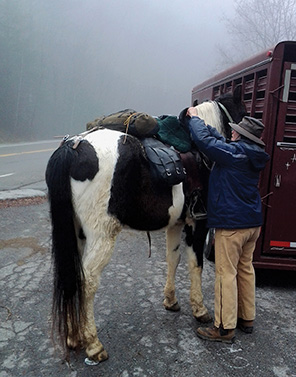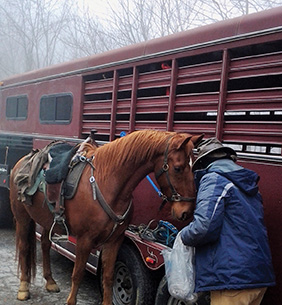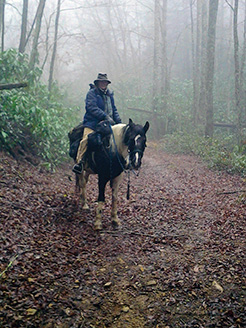“Well, if the other riders aren’t here by 11:30 a.m., we’ll go ahead,” said my guide. The dark-gray sky had stopped producing rain, but the temperature that December day was only 40 degrees.
I’m no stranger to cold. I’ve recently moved to Tennessee from Colorado. But this was my first trail ride in my new location.
I’d been looking for a friend with whom to explore the local trails. I was thrilled to meet Tori, an experienced guide.
“A lot of people stop trail riding in the winter months,” Tori had told me when we met the week before. “They pull their horses’ shoes and turn them out. Not me. I like to ride year-round.”
Tori Tolliver has ridden trails all over the South for years. She’s also a member of the Back Country Horseman of East Tennessee, a chapter of the Back Country Horsemen’s Association. She’s served as the treasurer and as a board member.
I’ve spent the majority of my life riding English, competing in hunter classes, dressage, and eventing. I’ve done some trail riding between competition and training work, but I’m not an experienced trail rider.
Tori had already planned to guide a ride the following week in the Cherokee National Forest, so she suggested this as our first ride.
She’d also mentioned that I might enjoy riding one of her horses, an offer I readily accepted. Not only were my own two rescue horses out of shape, but also Tori’s horses are smooth-gaited Tennessee Walking Horses.
I’m a “trotting-horse person,” as Tori calls it. I’d ridden gaited horses, but it’d been many years. I was looking forward to trying it again.
Tori herself is a convert from stock horses to Tennessee Walking Horses, Spotted Saddle Horses, and Racking Horses.
Shinbone Trail
So there we were on that cold December morning. I met up with Tori, who was hauling our mounts, at our designated spot. After waiting a while, we realized the cold, wet weather had kept the others at home, so it would just be the two of us.
I hopped into Tori’s truck, and we wound up the road to the trailhead in Cherokee National Forest, located in the southern Appalachian Mountains of east Tennessee.
We were destined for Shinbone Trail, a popular destination on Unaka Mountain, near Erwin. This 10-mile loop includes a section the locals call Eagle’s Nest, due to the stunning overlook of the Nolichucky River valley.
Unfortunately, we wouldn’t see any views that day due to the cloud cover, but I was looking forward to the adventure.
When we arrived at the trailhead parking lot, Tori tossed me some quilted overalls. I’d never ridden in overalls — when riding English, I found the less between you and the horse, the better.
As I stepped out of the warm truck into the cold air, however, I realized why Tori had given me that warm outerwear. We’d gained elevation on the drive, and the temperatures were now in the 30s.
The fog was thick on the mountain. Visibility was only about 100 feet, creating a quiet, ethereal feel. There was only one other car in the parking lot, left there by hikers on their way to the

Appalachian Trail.
My mount was C.J., a 10-year-old sorrel gelding. He’s a double-registered Tennessee Walking Horse/Spotted Saddle Horse who picks up both a smooth running walk and racking gait.
Tori rode her 17-year-old Tennessee Walking Horse gelding — a tough mountain horse.
As we saddled the horses, I studied the differences between Tori’s tack and the close-contact English saddles with which I’m most familiar.
C.J. wore an Eli Miller trail saddle, which offered room to accommodate a gaited horse’s active shoulder movement. Tori had added a breastcollar and crupper. A crupper attaches to the saddle then fits under the horse’s tail to keep the saddle from sliding forward while riding in the mountains.
I was relieved to see there was also a soft sheepskin pad on the saddle’s seat that would relieve pressure on my seat bones.
Comanche wore an endurance saddle from Tucker Trail Saddles. It looked extremely comfortable and fit Comanche well. He, too, sported a breastcollar and crupper.
Gliding in the Mist
Once the horses were tacked up, we donned warm riding gear: earmuffs; toe warmers; an extra fleece jacket; and warm gloves. As I mounted up, I felt my wiry little horse gather himself, excited and ready to go.
We went up a wide, slightly inclined trail, which was a mostly unused United States Forest Service road. Then the road soon became a double- and single-track through the woods, with little marking along the way. Fortunately, Tori knew the way.
I admired Tori’s skill on the trail. She’s experienced, knowledgeable, and well-prepared. This novice was in good hands.
Both horses were feeling frisky, so we let them go. I felt C.J. pick up speed, then break into a liquid-smooth rack.
It was a magical feeling, gliding through the mist and fog, horses stepping easily side-by-side. Our mounts relished this quick race up the hill.
C.J.’s movement felt effortless. I could hear the rhythm of his hooves beating the ground, but my body was still. The sensation was completely different from a two-beat trot or three-beat canter. However, we were moving just as fast. It felt as though we barely skimmed the ground.
We climbed up through the forest of rhododendron, mountain laurel, oak, maple, and hickory. The fog and mist conjured images of a medieval forest.

Power and Grace
I soon discovered that to maintain a smooth gait, it was best to keep my horse on the bit. This meant that I needed to apply leg pressure to engage his hips for hind-leg impulsion and to keep him moving forward into the bit.
This is the same technique I employ when riding a dressage horse, which uses impulsion from his hind legs for energetic forward movement. I found that a gaited horse must also use hind-leg impulsion to propel himself forward with power and grace.
There was little need to make rein contact with C.J.’s shanked bit. With light cues, he rounded his body, then softened his neck down.
I also paid attention to how I was riding. I’ve seen gaited riders with their legs out in front of them. However, I found that if I kept my legs back, aligned with my hips, and wrapped them around C.J.’s barrel, I encouraged him to round his body and lift his back.
This riding position made C.J.’s gait even smoother. He also blew softly and relaxed his jaw to show his appreciation.
Steep and Icy
We slowed as we came up to an ominously steep vertical descent. We decided to dismount. The previous night’s rain had made the footing extremely slippery. Tori showed me how to hold onto C.J.’s neck for balance as we carefully descended.
When we reached the bottom and mounted up again, we were rewarded with a lovely green forest of mountain laurel. I took note of the thick, waxy green leaves on tall bushes that would explode with pink flowers in the spring.
But spring felt very far off.
As we climbed out of the valley, I noticed the trees were coated in ice. Some trees had ice wings — horizontal sheets of ice — hanging off each branch. They had been shaped by freezing wind.
We stopped to rest, and Tori magically produced hot chocolate. We enjoyed a nice break, while the horses munched on the treats that Tori had brought along.
We mounted up and continued to climb. Switchbacks eased our ascent, but the trail turned out to be more challenging than we’d anticipated. As we turned around a switchback corner, I heard Tori say, “Uh-oh.”
Downed trees lay across on the trail. We dismounted to better survey the situation. We had to figure out what to do.

Trail Talk
As we considered our options, I asked Tori who maintained the trails in the area. She told me that the Back Country Horsemen of East Tennessee often teams up with local United States Forest Service officials to clear downed trees, repair trail the region. and perform other services. They help keep trails open for all users, not just equestrians.
We discussed the need for new trails to be opened for trail riding.
The state of Tennessee is planning a new state park in Rocky Fork, a beautiful mountainous area near the North Carolina border established with the help of the Conservation Fund, headquartered in Arlington, Virginia.
The BCHA also helps keep such trails open to horseback riders.
Tori explained that it’s important for trail riders to be involved, as there’s often competition for trail use. Other trail users also lobby for trail usage.
I vowed to get my membership form into the BCHA as soon as possible. I like the idea of being part of a process that keeps trails open for horseback riders.
Back to our dilemma. Tori decided we should lead the horses over the trees. C.J. and Comanche, seasoned and surefooted, carefully stepped over the branches. We were on our way.
As we rounded down the trail back to the trailer, I checked in with my back and hips, which usually hurt on long rides. I was surprised to find I was pain-free, thanks to C.J.’s smooth gait and my comfortable saddle.
Who knew riding in the mountains on a cold, December day could be so much fun? Maybe Tori is onto something here.
Not just riding year-round, but also riding the trails on smooth-gaited horses.
Cate Lamm, The Trail Rider’s editorial assistant, owns two rescue horses, Banjo and Sensei. Read her rescue-horse blog on TrailRiderMag.com.
Appalachian Trails
Here’s a guide to public lands, private equestrian getaways, private horse camps, and guided rides in the southern Appalachians.
Public Lands
Cherokee National Forest
(423) 476-9700
www.fs.usda.gov/cherokee
Lost Corral Horse Camp
https://tinyurl.com/mttk4y3
Mount Rogers National
Recreation Area
(888) 265-0019
www.fs.usda.gov
Virginia Creeper Trail
www.vacreepertrail.us
Young Branch Horse Camp
https://tinyurl.com/kbbv5cz
Private Equestrian Getaways
Billingsway Farm & Rustic
Retreat
(276) 237-1300
www.billingswayfarmrusticretreat.com
Blanche Manor, LLC
(706) 455-7433
www.blanchemanor.com
Fort Valley Ranch
(540) 933-6633
www.fortvalleyranch.com
Meadow Creek Mountain
Rustic Resort
(423) 623-7543
www.meadowcreekmountain.com
Private Horse Camps
Cherokee Trails Campground
& Stables
(423) 391-0118
www.cherokeetrailscampground.com
High Country Horse Camp
(276) 388-3992
www.highcountryhorsecampva.com
Kissing Rock Campground
(276) 677-3851
www.kissingrockcamp.com
Guided Rides
Hidden Hills Farm
(423) 488-3993
www.hiddenhillsfarm.com
Mustang Alley
(423) 552-5988
www.mustangalleyridingstables.com
Article Resource Guide
Back Country Horsemen’s Association
(888) 893-5161
www.backcountryhorse.com
Back Country Horsemen of East Tennessee
www.bchet.org
Cherokee National Forest
(423) 476-9700
www.fs.usda.gov/cherokee
Conservation Fund
(703) 525-6300
www.conservationfund.org
Eli Miller Saddles
(606) 526-1897
www.customcomfortsaddles.com
Tucker Trail Saddles
(800) 882-5375
www.tuckersaddlery.com




